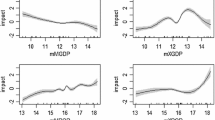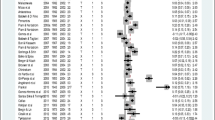Abstract
We investigate bilateral trade flows across the EU-15 countries from 1962 to 2003 by different specifications of the gravity model. We augment the basic gravity model with population and exchange rate variables, and then include time-varying country fixed effects, to account for Anderson and van Wincoop (Am Econ Rev 93(1):170–192, 2003) multilateral resistance terms. Then, following the previous theoretical derivations of the gravity model in the presence of panel data in a dynamic setting we change the specification of our gravity model. We compare the results of different specifications showing the improvement in each case. We claim the comparative superiority of the dynamic gravity model with time-varying exporter and importer fixed effects due to its higher explanatory power. Finally, we compare out-of-sample forecasting performance of different specifications of the gravity model.
Similar content being viewed by others
Notes
The original gravity equation explains the value of spending by one nation on the goods produced by another nation; therefore, it is better to use uni-directional trade flows instead of taking the average of the two way exports in estimations to avoid some mistakes made in the gravity literature (Baldwin and Taglioni 2006).
References
Anderson JE (1979) A theoretical foundation for the gravity equation. Am Econ Rev 69(1):106–116
Anderson JE, van Wincoop E (2003) Gravity with Gravitas: a solution to the border puzzle. Am Econ Rev 93(1):170–192
Bacchetta P, van Wincoop E (2000) Does exchange rate stability increase trade and welfare? Am Econ Rev 90(5):1093–1109
Baldwin R, Taglioni D (2006) Gravity for dummies and dummies for gravity equations. NBER Working Paper: 12516
Baltagi BH, Egger P, Pfaffermayr M (2003) A generalized design of bilateral trade flow models. Econ Lett 80:391–397
Bergstrand JH (1989) The generalized gravity equation, monopolistic competition, and the factor-proportions theory in international trade. The Rev Econ Stat 71(1):143–153
Chowdhury AR (1993) Does exchange rate volatility depress trade flows? evidence from error correction models. The Rev Econ Stat 75(4):700–706
Clark P, Tamirisa N, Wei SJ, Sadikov A, Zeng L (2004) Exchange rate volatility and trade flows—some new evidence. IMF
Dell’Ariccia G (1999) Exchange rate fluctuations and trade flows: evidence from the European union. IMF Staff Pap 46(3):315–334
Egger P, Pfaffermayr M (2003) The proper panel econometric specification of the gravity equation: a three-way model with bilateral interaction effects. Empir Econ 28:571–580
Frank RH, Bernanke BS (2007) Principles of economics. McGraw Hill/Irwin, New York
Feenstra R (2004) Advanced international trade: theory and evidence. Princeton University Press, New Jersey
Harris MN, Matyas L (1998) The econometrics of gravity models. Melbourne Institute Working Paper 5/98
Huang RR (2007) Distance and trade: disentangling unfamiliarity effects and transport cost effects. Eur Econ Rev 51:161–181
Jacquemin A, Sapir A (1988) International trade and integration of the European community: an econometric analysis. Eur Econ Rev 32:1439–1449
Lane PR, Milesi-Ferretti GM (2002) External wealth, the trade balance and the real exchange rate. Eur Econ Rev 46:1049–1071
Matyas L (1997) Proper econometric specification of the gravity model. World Econ 20(3):363–368
Nickell S (1981) Biases in dynamic models with fixed effects. Econometrica 49(6): 1417–1426
Nuroglu E, Kunst RM (2012) The effects of exchange rate volatility on international trade flows: evidence from panel data analysis and fuzzy approach. Proc Rij Fac Econ J Econ Bus 30(1):9–31
Olivero M, Yotov Y (2010) Dynamic gravity: endogenous country size and asset accumulation. Can J Econ 45(1):64–92
Perée E, Steinherr A (1989) Exchange rate uncertainty and foreign trade. Eur Econ Rev 33:1241–1264
Tinbergen J (1962) Shaping the world economy: suggestions for an international economic policy. Twentieth Century Fund, New York
Author information
Authors and Affiliations
Corresponding author
Rights and permissions
About this article
Cite this article
Nuroğlu, E., Kunst, R.M. Competing specifications of the gravity equation: a three-way model, bilateral interaction effects, or a dynamic gravity model with time-varying country effects?. Empir Econ 46, 733–741 (2014). https://doi.org/10.1007/s00181-013-0696-3
Received:
Accepted:
Published:
Issue Date:
DOI: https://doi.org/10.1007/s00181-013-0696-3
Keywords
- Gravity model
- Exporter effects
- Importer effects
- Time effects
- Bilateral interaction effects
- Time varying fixed effects
- Dynamic gravity




